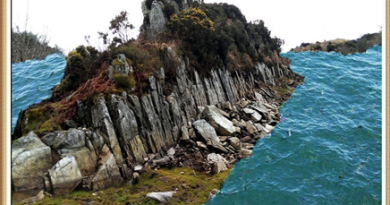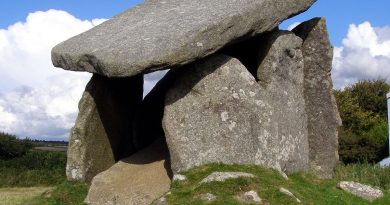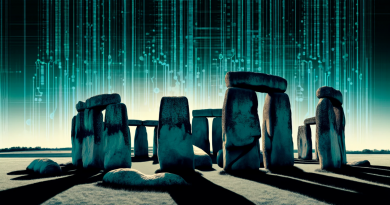Stonehenge – Monument to the Dead
Extract from the book: The Stonehenge Enigma (Stonehenge – Monument to the Dead)
The most popular view of Stonehenge is false facts for it was not a completely round monument with lintel stones completing the circle – but there is a massive problem with this idea, for not all the stones or the stone holes are present. Some people have suggested that the monument is incomplete, but those individuals do not understand its significance and the reason behind the construction.
A monument to the dead as we have previously illustrated, would not face the Summer Solstice Sunrise, it would either face the moon’s furthest setting in the night’s sky (the northwest and the lost Mesolithic pathway) or it would face Winter Solstice Sunset to mark the shortest day – when light finally overcomes the darkness the symbolism of rebirth (life after death).
Another reason to ignore the reference to a solar temple, is that the Sun is usually represented as life and a circular symbol as we see in many ancient civilisations in the Middle East and South and Central America – where monuments to the dead are represented by the moon and particularly, a crescent moon.

| Figure 36– Stonehenge was ‘crescent’ shaped not round |
Stonehenge was designed to be crescent-shaped, with an alignment to the Winter Solstice Sunset and hence the construction and alignment with a trilithon (two standing stones with a third suspended on top of the two uprights) in the south-west quadrant. Which only one survives and is still upright, which is not surprising as the druids in the Iron Age altered the monuments symbology by pulling the Heel stone to an awkward angle to meet the sunrise of the Summer Solstice, and no doubt pulled down the trilithon in the south-west quadrant.
The ‘crescent within the crescent’ (the larger horseshoe trilithon standing stones) that faces the Summer solstice sunrise; this is very symbolic as it represents rebirth or reincarnation, it’s a poignant message through the ages to us (the descendants of this civilisation), that their homeland may be dead, but the survivors still live on, to begin again.
This can be proven in various ways. In archaeological terms, the fact that the stones are missing is a problem for archaeologists, unless the monument was incomplete.

| Figure 37 – Stonehenge hexagonal design |
All the so-called missing stones of the monument are in the SW quadrant; this area is the furthest away from any roads – if you are going to cart away stones would you not start at a point nearest a road, rather than the stones furthest away. The second problem with the Solar temple is that some of the existing stones that have not been moved or chipped away are not large enough to take a horizontal lintel stone – such as stone 11. Consequently, the only type of monument that the site could have been designed for is the crescent moon facing the Winters Solstice Sunset.
This is confirmed if you consider how the structure was designed. It would have been based using strings to the centre and the moat forming a Hexagram (the reason this form was used is further discussed in the last book of the trilogy: ‘Dawn of the Lost Civilisation’).
Do you want more Stonehenge Facts?
More information (and Stonehenge facts) are contained in our documentary: https://youtu.be/OWMso5UgUWU
Further Reading
For information about British Prehistory, visit www.prehistoric-britain.co.uk for the most extensive archaeology blogs and investigations collection, including modern LiDAR reports. This site also includes extracts and articles from the Robert John Langdon Trilogy about Britain in the Prehistoric period, including titles such as The Stonehenge Enigma, Dawn of the Lost Civilisation and the ultimate proof of Post Glacial Flooding and the landscape we see today.
Robert John Langdon has also created a YouTube web channel with over 100 investigations and video documentaries to support his classic trilogy (Prehistoric Britain). He has also released a collection of strange coincidences that he calls ‘13 Things that Don’t Make Sense in History’ and his recent discovery of a lost Stone Avenue at Avebury in Wiltshire called ‘Silbury Avenue – the Lost Stone Avenue’.
Langdon has also produced a series of ‘shorts’, which are extracts from his main body of books:
For active discussions on the findings of the TRILOGY and recent LiDAR investigations that are published on our WEBSITE, you can join our and leave a message or join the debate on our Facebook Group.



